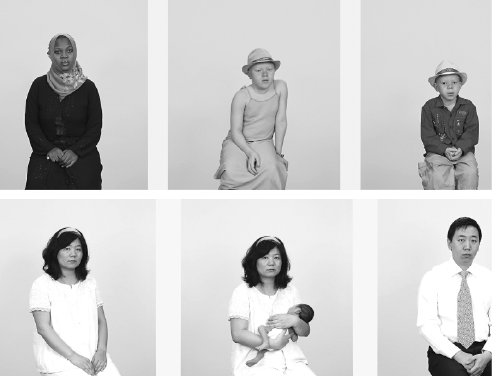
TARYN SIMON/CHINA DAILY
Photos from Taryn Simon's work that investigates 18 family bloodlines.
American photographer Taryn Simon has turned her lens on families, traveling across continents to capture the invisible ties that bind. Chen Nan discovers why the artist is drawn to challenging projects.
"In Uttar Pradesh, India, land provides the primary source of income for most residents. Exponential population growth, property shortages, and repeated subdivision have heightened competition for land. Records officials are frequently bribed to have living people declared dead in order to redirect the hereditary transfer of land to new owners. These bribes commonly range from 45 to 2,250 INR ($1-50)."
These are the words American artist Taryn Simon wrote next to 23 photos she took on a visit to India four years ago.
Her photos document the family of Shivdutt Yadav, who discovered that official records listed him as dead. His land was no longer registered in his name and was transferred to the other heirs of Yadav's father, who threatened to destroy his property unless he moved away.
"As a photographer, this was a particularly complex situation as photographs are often used as a 'proof of life' and here I was taking portraits of people who don't exist. I was photographing ghosts," she says.
The 23 photos, titled A Living Man Declared Dead, made her think about fate and its relationship to chance, blood, and circumstance. The experience also forced her beyond borders to more than 20 different countries over the past four years.
She has created a work that investigates 18 family bloodlines. Her subjects take in polygamy in Kenya, the first woman in the world to hijack an aircraft, and children at Ukrainian orphanage. In 2009,she visited China to take pictures of Su Jianqi's 29 family members from Beijing.
After showing at London's Tate Modern, New York's MoMA and Berlin's Neue Nationalgalerie, the exhibition, A Living Man Declared Dead And Other Chapters I-XVIII is being shown at UCCA in Beijing, marking its premiere in Asia.
Following the tradition of her father and grandfather, who both worked extensively with image and text, the New York-based artist's work often catalogues something that is quite abstract conceptually but in giving these projects a determined title. She tells a story.
For Simon, whose artistic medium consists of three equal elements: photography, text, and graphic design, the experience of photographing bloodlines enabled her to "think in the opposite direction".
"I wanted to find an absolute catalogue-one that couldn't be edited or curated by choice, and something in which I couldn't determine my own path. This led me to blood," she says.
"We believe that Taryn Simon's unique ability to combine photographic image, journalistic research, and writerly narrative will find a receptive audience here," says UCCA Director Philip Tinari.
Each project starts with research and writing, which slowly unravels into actual production. The artist usually imagines an idea and then tries to locate it in reality, which often turns out different than the original idea.
"I may have read about something in a novel, seen an article, heard or even misheard something in a conversation. I then start down a path of research, which often winds out into something I could never invent. The actual taking of the photographs collectively amounts to about a year of time. The rest is researching, accessing, organizing and writing," she says.
The process was exhausting and unpredictable. Along the way, she was confronted with incidents such as natural disasters or rejection from local authorities.
Together with her assistant, Simon traveled to four or five different countries following the migratory patterns of the individuals in that bloodline. There were works that saw her coordinate with over 100 individuals, trying to locate them and getting their agreement to participate. There was a rigorous mapping of each bloodline and they had to constantly be sure everyone was contacted and all lines were accounted for.
"But even that rigor couldn't prevent the inevitable disruption. I would show up and suddenly someone mentions a brother that had never been previously discussed with me," she says.
When they traveled with a ton of gear to accommodate their moving studio to Tanzania to photograph the bloodline of the director of the Tanzania Albino Society, their equipment was seized by corrupt authorities and $80,000 was demanded for its return.
"Albinos in Tanzania are hunted by human poachers who trade their skin, limbs and organs for large sums of money to witch doctors who promote the belief that albinos have magical powers. This is a subject the authorities are not keen to publicize," she says.
For the people she wants to photograph, there was typically an understanding and desire to participate. But for those who didn't show up because of reasons ranging from imprisonment, military service, women not granted permission to be photographed for religious and social reasons or individuals who didn't want to be associated with the story, she uses empty portraits.
She has published her photography since 2003, with The Innocents, documenting stories of people who served time in prison for violent crimes they didn't commit.
In 2007,she confronted the divide between public and expert access through An American Index of the Hidden and Unfamiliar, to see how far she could get as an individual citizen, or outsider.
Contact the writer at chennan@chinadaily.com.cn.
IF YOU GO
Until Jan 5,2014.Ullens Center for Contemporary Art,798 Art District, No 4 Jiuxianqiao Lu, Chaoyang district, Beijing.010-5780-0200.
We recommend:
